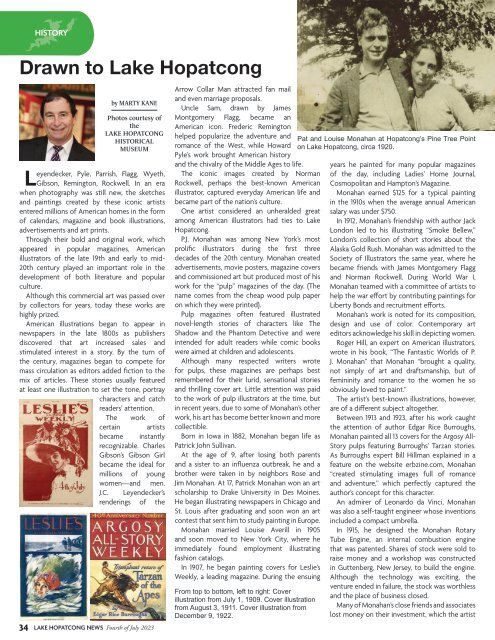You also want an ePaper? Increase the reach of your titles
YUMPU automatically turns print PDFs into web optimized ePapers that Google loves.
HISTORY<br />
Drawn to Lake Hopatcong<br />
Leyendecker, Pyle, Parrish, Flagg, Wyeth,<br />
Gibson, Remington, Rockwell. In an era<br />
when photography was still new, the sketches<br />
and paintings created by these iconic artists<br />
entered millions <strong>of</strong> American homes in the form<br />
<strong>of</strong> calendars, magazine and book illustrations,<br />
advertisements and art prints.<br />
Through their bold and original work, which<br />
appeared in popular magazines, American<br />
illustrators <strong>of</strong> the late 19th and early to mid-<br />
20th century played an important role in the<br />
development <strong>of</strong> both literature and popular<br />
culture.<br />
Although this commercial art was passed over<br />
by collectors for years, today these works are<br />
highly prized.<br />
American illustrations began to appear in<br />
newspapers in the late 1800s as publishers<br />
discovered that art increased sales and<br />
stimulated interest in a story. By the turn <strong>of</strong><br />
the century, magazines began to compete for<br />
mass circulation as editors added fiction to the<br />
mix <strong>of</strong> articles. These stories usually featured<br />
at least one illustration to set the tone, portray<br />
characters and catch<br />
readers’ attention.<br />
The work <strong>of</strong><br />
certain artists<br />
became instantly<br />
recognizable. Charles<br />
Gibson’s Gibson Girl<br />
became the ideal for<br />
millions <strong>of</strong> young<br />
women—and men.<br />
J.C. Leyendecker’s<br />
renderings <strong>of</strong> the<br />
34<br />
by MARTY KANE<br />
Photos courtesy <strong>of</strong><br />
the<br />
LAKE HOPATCONG<br />
HISTORICAL<br />
MUSEUM<br />
LAKE HOPATCONG NEWS <strong>Fourth</strong> <strong>of</strong> <strong>July</strong> <strong>2023</strong><br />
Arrow Collar Man attracted fan mail<br />
and even marriage proposals.<br />
Uncle Sam, drawn by James<br />
Montgomery Flagg, became an<br />
American icon. Frederic Remington<br />
helped popularize the adventure and<br />
romance <strong>of</strong> the West, while Howard<br />
Pyle’s work brought American history<br />
and the chivalry <strong>of</strong> the Middle Ages to life.<br />
The iconic images created by Norman<br />
Rockwell, perhaps the best-known American<br />
illustrator, captured everyday American life and<br />
became part <strong>of</strong> the nation’s culture.<br />
One artist considered an unheralded great<br />
among American illustrators had ties to Lake<br />
Hopatcong.<br />
P.J. Monahan was among New York’s most<br />
prolific illustrators during the first three<br />
decades <strong>of</strong> the 20th century. Monahan created<br />
advertisements, movie posters, magazine covers<br />
and commissioned art but produced most <strong>of</strong> his<br />
work for the “pulp” magazines <strong>of</strong> the day. (The<br />
name comes from the cheap wood pulp paper<br />
on which they were printed).<br />
Pulp magazines <strong>of</strong>ten featured illustrated<br />
novel-length stories <strong>of</strong> characters like The<br />
Shadow and the Phantom Detective and were<br />
intended for adult readers while comic books<br />
were aimed at children and adolescents.<br />
Although many respected writers wrote<br />
for pulps, these magazines are perhaps best<br />
remembered for their lurid, sensational stories<br />
and thrilling cover art. Little attention was paid<br />
to the work <strong>of</strong> pulp illustrators at the time, but<br />
in recent years, due to some <strong>of</strong> Monahan’s other<br />
work, his art has become better known and more<br />
collectible.<br />
Born in Iowa in 1882, Monahan began life as<br />
Patrick John Sullivan.<br />
At the age <strong>of</strong> 9, after losing both parents<br />
and a sister to an influenza outbreak, he and a<br />
brother were taken in by neighbors Rose and<br />
Jim Monahan. At 17, Patrick Monahan won an art<br />
scholarship to Drake University in Des Moines.<br />
He began illustrating newspapers in Chicago and<br />
St. Louis after graduating and soon won an art<br />
contest that sent him to study painting in Europe.<br />
Monahan married Louise Averill in 1905<br />
and soon moved to New York City, where he<br />
immediately found employment illustrating<br />
fashion catalogs.<br />
In 1907, he began painting covers for Leslie’s<br />
Weekly, a leading magazine. During the ensuing<br />
From top to bottom, left to right: Cover<br />
illustration from <strong>July</strong> 1, 1909. Cover illustration<br />
from August 3, 1911. Cover illustration from<br />
December 9, 1922.<br />
Pat and Louise Monahan at Hopatcong’s Pine Tree Point<br />
on Lake Hopatcong, circa 1920.<br />
years he painted for many popular magazines<br />
<strong>of</strong> the day, including Ladies’ Home Journal,<br />
Cosmopolitan and Hampton’s Magazine.<br />
Monahan earned $125 for a typical painting<br />
in the 1910s when the average annual American<br />
salary was under $750.<br />
In 1912, Monahan’s friendship with author Jack<br />
London led to his illustrating “Smoke Bellew,”<br />
London’s collection <strong>of</strong> short stories about the<br />
Alaska Gold Rush. Monahan was admitted to the<br />
Society <strong>of</strong> Illustrators the same year, where he<br />
became friends with James Montgomery Flagg<br />
and Norman Rockwell. During World War I,<br />
Monahan teamed with a committee <strong>of</strong> artists to<br />
help the war effort by contributing paintings for<br />
Liberty Bonds and recruitment efforts.<br />
Monahan’s work is noted for its composition,<br />
design and use <strong>of</strong> color. Contemporary art<br />
editors acknowledge his skill in depicting women.<br />
Roger Hill, an expert on American illustrators,<br />
wrote in his book, “The Fantastic Worlds <strong>of</strong> P.<br />
J. Monahan” that Monahan “brought a quality,<br />
not simply <strong>of</strong> art and draftsmanship, but <strong>of</strong><br />
femininity and romance to the women he so<br />
obviously loved to paint.”<br />
The artist’s best-known illustrations, however,<br />
are <strong>of</strong> a different subject altogether.<br />
Between 1913 and 1923, after his work caught<br />
the attention <strong>of</strong> author Edgar Rice Burroughs,<br />
Monahan painted all 13 covers for the Argosy All-<br />
Story pulps featuring Burroughs’ Tarzan stories.<br />
As Burroughs expert Bill Hillman explained in a<br />
feature on the website erbzine.com, Monahan<br />
“created stimulating images full <strong>of</strong> romance<br />
and adventure,” which perfectly captured the<br />
author’s concept for this character.<br />
An admirer <strong>of</strong> Leonardo da Vinci, Monahan<br />
was also a self-taught engineer whose inventions<br />
included a compact umbrella.<br />
In 1915, he designed the Monahan Rotary<br />
Tube Engine, an internal combustion engine<br />
that was patented. Shares <strong>of</strong> stock were sold to<br />
raise money and a workshop was constructed<br />
in Guttenberg, New Jersey, to build the engine.<br />
Although the technology was exciting, the<br />
venture ended in failure, the stock was worthless<br />
and the place <strong>of</strong> business closed.<br />
Many <strong>of</strong> Monahan’s close friends and associates<br />
lost money on their investment, which the artist
















